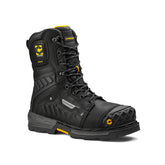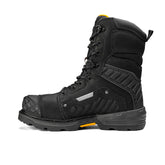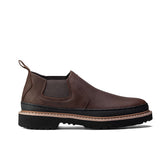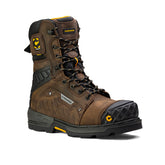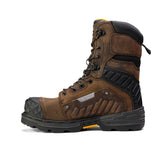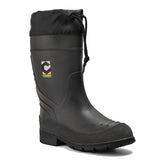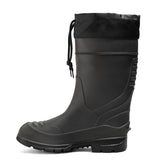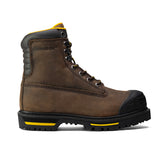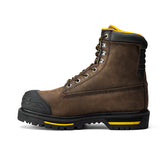How to Select Boots for Electrical Hazard Protection (EH)
When your job demands you work around live wires, electrical panels, or high-voltage equipment, your boots aren’t just another piece of gear—they’re a lifeline.
How to Choose Boot with Electrical Hazard (EH) Protection?
Choosing the right boots for electrical hazard (EH) protection isn’t about guesswork. It’s about understanding what’s at stake and making an informed choice that prioritizes your safety, comfort, and productivity. Here are some of the most critical things to consider when purchasing an EH boot.
- Electrical Hazard Ratings
- Boot Material
- Fit and Comfort
- Slip Resistance
- Waterproofing and Breathability
- Boot Weight
- Longevity
Understand Electrical Hazard Ratings
Not all work boots are created equal, and some might only offer the illusion of protection. Electrical hazard (EH) rated boots are specifically designed to reduce the risk of electric shock by insulating the wearer from the ground. These boots are tested to withstand up to 18,000 volts at 60 Hz for a full minute under dry conditions. It’s a stringent standard—and for good reason. Without this rating, you’re rolling the dice with your safety.
Look for the ASTM F2413-18 EH rating on the label. This ensures the boots meet strict safety criteria, providing a reliable barrier against accidental contact with live electrical circuits. Skip boots that can’t verify this certification; your safety is too important for compromises.
Materials Matter: Leather and Non-Conductive Soles
Durability, protection, and comfort all start with the materials. EH boots typically feature uppers made from full-grain leather, known for its toughness and ability to resist wear and tear. Leather is also naturally non-conductive, adding an extra layer of safety.
The soles, on the other hand, play a crucial role in insulating you from the ground. Rubber and polyurethane are common choices—and for good reason. These materials provide excellent electrical resistance, along with slip resistance, which is often equally critical on the job. Avoid boots with metal components in the sole or shank, as these can conduct electricity and negate the protective qualities of the boot.
Prioritize Fit and Comfort for Long Days
Safety features mean little if your boots make every step a painful reminder of poor design. Long shifts demand boots that don’t just protect but support you. Start with the basics: ensure there’s enough room in the toe box to wiggle your toes and that your heels don’t slip when walking.
Many EH boots come with padded insoles, arch support, and moisture-wicking linings to enhance comfort. If the factory insoles aren’t cutting it, consider aftermarket orthotics. After all, tired feet can lead to mistakes—and in your line of work, that’s not an option.
Slip Resistance: A Critical Factor
Electrical hazards are often paired with slippery surfaces, whether it’s a wet floor or an oil-slicked workspace. Boots that prioritize electrical safety but skimp on slip resistance leave you vulnerable to other dangers. Look for outsoles with deep lugs and anti-slip technology designed to maintain traction in challenging environments. A good grip isn’t just about convenience—it’s about staying upright and focused.
Consider Waterproofing and Breathability
Your boots must be as resilient as your workday. Waterproofing is a crucial feature for those exposed to outdoor elements or damp indoor conditions. Look for designs that use waterproof membranes or sealed seams to keep moisture out.
But don’t forget breathability. Overlook this, and you’ll be swapping one discomfort for another as sweat builds up inside your boots. Moisture-wicking linings and breathable materials ensure your feet stay dry—even when the jobsite’s conditions are anything but.
Boot Weight: Don’t Underestimate It
Heavy boots can slow you down and add fatigue to an already demanding day. Lightweight EH boots—often made with advanced materials like composite toe caps instead of steel—offer the same level of protection without the added burden. Pay attention to the overall weight, especially if your job requires a lot of walking or climbing.
Boot Longevity: Invest in Quality
Boots for electrical hazard protection aren’t a place to cut corners. Quality EH boots may come with a higher price tag, but they’re built to last. Durable stitching, reinforced toe boxes, and high-quality materials mean your boots won’t just meet safety standards but exceed them—for years.
Regular maintenance also extends their life. Clean them after exposure to dirt or chemicals, condition the leather periodically, and replace insoles as needed. A little care goes a long way in keeping your investment intact.
Test and Reassess
Even the best boots can lose their protective qualities over time. Regularly inspect your EH boots for signs of wear—cracks in the soles, thinning leather, or worn-out tread. Replace them if they no longer meet safety standards. It’s better to spend a little now than risk a costly accident later.
Your Safety, Your Choice
Selecting boots for electrical hazard protection isn’t a decision to take lightly. The right pair becomes a trusted ally, allowing you to focus on the task at hand without second-guessing your safety gear.
Chinook Footwear offers a range of EH-rated boots that combine cutting-edge protection with all-day comfort, ensuring you’re ready for whatever the job demands. Because when your work involves high stakes, every detail—right down to your boots—matters.

